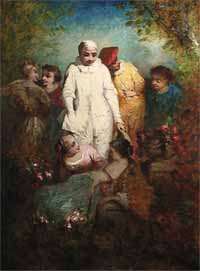Narcisse Virgilio Díaz

Narcisse Virgilio Díaz de la Peña (20 August 1807 – 18 November 1876) was a French painter of the Barbizon school.
Life


Diaz was born in Bordeaux to Spanish parents. At the age of ten, Diaz became an orphan, and misfortune dogged his early years. His foot was bitten by a reptile in Meudon wood, near Sèvres, where he had been taken to live with some friends of his mother. The bite was poorly dressed, and ultimately he lost his leg. However, as it turned out, the wooden stump that replaced his leg became famous.
At fifteen he entered the studios at Sèvres, first working in the decoration of porcelain occupied him and later turning to painting. Turkish and Oriental scenes attracted him, and he took to painting Eastern figures dressed in richly coloured garments; many of these paintings remain extant. He also spent much time at Barbizon.[citation needed] One of his teachers and friends in Paris was François Souchon.[1]
Around 1831 Díaz encountered Théodore Rousseau, for whom he possessed a great veneration, despite the fact that Rousseau was four years younger. At Fontainebleau Díaz found Rousseau painting his wonderful forest pictures, and was determined to paint in the same way if possible. However, Rousseau was then in poor health, embittered against the world, and consequently was difficult to approach. On one occasion, Diaz followed him surreptitiously to the forest, with his wooden leg hindering, and he dodged round after the painter, trying to observe his method of work. After a time Díaz found a way to become friendly with Rousseau, and revealed his eagerness to understand the latter's techniques. Rousseau was touched with the passionate words of admiration, and finally taught Diaz all he knew.
Díaz exhibited many pictures at the Paris Salon, and was decorated in 1851. During the Franco-German War he went to Brussels. After 1871, his works became fashionable and rose gradually in the estimation of collectors, and he worked constantly and successfully. Díaz's finest pictures are his forest scenes and storms, and it is on these that his fame rests.[citation needed] There are several examples of his work in the Louvre, and three small figure pictures in the Wallace Collection, Hertford House. Perhaps the most notable of Diaz's works are "La Fée aux Perles" (1857, housed in the Louvre); "Sunset in the Forest" (1868); "The Storm" and "The Forest of Fontainebleau" (1870, housed at Leeds).
Diaz himself had no well-known pupils, but François Visconti showed emulation his work to some degree and Léon Richet followed markedly his methods of tree-painting. For a period, Jean-François Millet also painted small figures in avowed imitation of Diaz's then popular subjects.[citation needed] Renoir once said "my hero was Díaz".[2] In 1876, while visiting his son's grave, he caught a cold. He went to Menton in an attempt to recover his health, but on November 18 of that year he died. In 1851, he was decorated with the rank of Chevalier (Knight) of the Légion d’honneur.[3]

Díaz's son, Eugène-Émile (1837–1901), achieved some fame as composer Eugène Diaz.[4]
Further reading
- A. Hustin, Les Artistes célébres: Diaz (Paris)
- David Croal Thomson, The Barbizon School of Painters (London, 1890)
- J.W. Mollett, Diaz (London, 1890)
- Jules Arsène Arnaud Claretie, Peintres et sculpteurs contemporains: Diaz (Paris, 1882)
- Albert Wolff, La Capitale de l'art: Narcisse Diaz (Paris, 1886)
- Philippe Burty, Maîtres et petit-maîtres: N. Diaz (Paris, 1877)
Notes
This article includes a list of general references, but it lacks sufficient corresponding inline citations. (February 2014) |
- ^ Dévémy, L. (1875). "Notices biographiques sur François Souchon, peintre et le P. Hyacinthe Besson, son élève". Mémoires de la société d'agriculture, sciences & arts centrale du département du Nord séant a Douai. Retrieved 2014-06-21.
- ^ "Renoir: An Intimate Record", Page 9.
- ^ "Narcisse Virgilio Diaz de la Pena," Schiller and Bodo European Paintings
- ^ Cinq lettres autographes signées d'Eugène Diaz à Adolphe Dupeuty, 18 mars et 11 juillet 1873, 1874 et sans date, Institut national de l'histoire de l'art. Retrieved 2012-04-15.
References
- "Narcisse-Virgilio Diaz de la Peña - artist - 1807 - 1876". The National Gallery, London. Retrieved 1 February 2016.
- "Art Renewal Center Museum™ Artist Information for Narcisse-Virgile Diaz de la Peña (Narcisse Virgile Diaz de la Pena)". Art Renewal Center. 28 July 2007. Retrieved 1 February 2016.
Attribution
- This article incorporates text from a publication now in the public domain: "Diaz, Narcisse Virgilio". Encyclopædia Britannica. Vol. 8 (11th ed.). 1911.
Further reading
- O'Neill, J, ed. (2000). Romanticism & the school of nature : nineteenth-century drawings and paintings from the Karen B. Cohen collection. New York: The Metropolitan Museum of Art. (see index)
